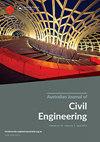Investigating the combined effect of aggregate size and sulphate attack on producing sustainable recycled aggregate concrete
IF 1.6
Q3 ENGINEERING, CIVIL
引用次数: 10
Abstract
ABSTRACT This study investigates the performance of recycled aggregate concrete incorporating different sizes and concentrations of coarse aggregate under sodium sulphate and normal water curing. Ten mixes were produced, having two control mixes of 12 to 20 mm and 5 to 12 mm coarse aggregate size. The rest of the mixes have supplementary cementitious material with 0%, 15%, 30%, and 45% substitution of respective sizes normal aggregate by recycled aggregate. The fresh recycled aggregate concrete mixes were assessed through the slump, ball penetration, and compacting factor test, which exhibited a falling trend with the percentage increase of recycled aggregate. Moreover, compressive strength and ultrasonic pulse velocity drop with the percentage of RCA increases at 7, 28, and 91-days normal curing and 5% Na2SO4 solution curing at 91 days. The compressive strength and ultrasonic pulse velocity of 5-12 mm coarse aggregate concrete showed improvement over 12–20 mm coarse aggregate concrete of the same replacement for both curing. However, 5% Na2SO4 solution curing specimens exhibit around 5–11% decrease in compressive strength and higher penetration depth than normal curing . Furthermore, the outer face of the silica fume included samples have received fewer white patches after sodium sulphate immersion.研究了骨料粒度和硫酸盐侵蚀对可持续再生骨料混凝土生产的综合影响
本文章由计算机程序翻译,如有差异,请以英文原文为准。
求助全文
约1分钟内获得全文
求助全文

 求助内容:
求助内容: 应助结果提醒方式:
应助结果提醒方式:


